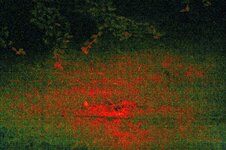David Villanueva, has discovered that digital cameras can be easily adapted to reveal the location of buried treasure from up to several hundred yards away.
Having successfully used a Polaroid camera for photographing auras given off by buried metal for a number of years, David was horrified when Polaroid stopped making the film in 2005 and usable original film quickly became unavailable at any price. In the short-term alternative film is available, which photographs treasure auras at least as well as the original film but Polaroid’s recent decision to cease all instant film production would make photographing treasure auras history…unless digital cameras could be used.
However, digital camera technology is very different to that of film cameras and what worked with Polaroid failed with digital. A complete re-think was needed! The breakthrough came after David learned of treasure hunters successfully using a highly specialised digital camera to locate caches buried along Spanish mule-train trails. So clearly it was possible to photograph auras digitally but could it be done without spending a fortune on high-tech equipment? After three years of intensive research the answer is absolutely yes! Some, possibly many, popular digital cameras are up to the task.
Using readily available photographic accessories that anyone can easily attach, without causing damage, the digital cameras tested were able to record an aura, from a distance, on a single quarter-ounce (seven-gram) gold sovereign coin buried six inches (150mm) underground. In extensive field trials cameras located buried metal over two feet (610mm) deep and could discriminate between different metals. The cameras could be hand-held or tripod-mounted and could capture auras anytime during daylight hours in a wide range of weather conditions. A colleague invited to test the system, with his own camera, clearly demonstrated that no special skill or ability was necessary by obtaining an aura on the first attempt.
The attached digital photograph shows an aura from one ounce of buried gold.
Having successfully used a Polaroid camera for photographing auras given off by buried metal for a number of years, David was horrified when Polaroid stopped making the film in 2005 and usable original film quickly became unavailable at any price. In the short-term alternative film is available, which photographs treasure auras at least as well as the original film but Polaroid’s recent decision to cease all instant film production would make photographing treasure auras history…unless digital cameras could be used.
However, digital camera technology is very different to that of film cameras and what worked with Polaroid failed with digital. A complete re-think was needed! The breakthrough came after David learned of treasure hunters successfully using a highly specialised digital camera to locate caches buried along Spanish mule-train trails. So clearly it was possible to photograph auras digitally but could it be done without spending a fortune on high-tech equipment? After three years of intensive research the answer is absolutely yes! Some, possibly many, popular digital cameras are up to the task.
Using readily available photographic accessories that anyone can easily attach, without causing damage, the digital cameras tested were able to record an aura, from a distance, on a single quarter-ounce (seven-gram) gold sovereign coin buried six inches (150mm) underground. In extensive field trials cameras located buried metal over two feet (610mm) deep and could discriminate between different metals. The cameras could be hand-held or tripod-mounted and could capture auras anytime during daylight hours in a wide range of weather conditions. A colleague invited to test the system, with his own camera, clearly demonstrated that no special skill or ability was necessary by obtaining an aura on the first attempt.
The attached digital photograph shows an aura from one ounce of buried gold.







